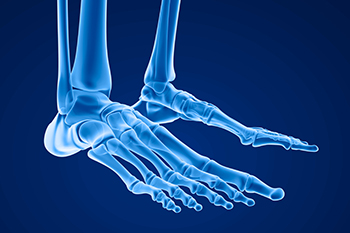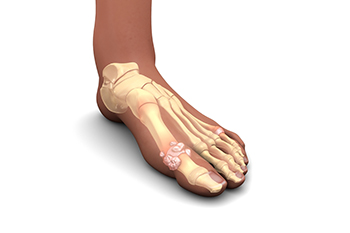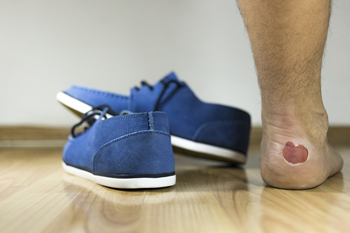
Wilmington (937) 382-2347
Fax
(513) 932-1606

Wilmington (937) 382-2347
Fax
(513) 932-1606

The feet and ankles are complex structures. The 26 bones, several muscles, tendons, and ligaments work together in harmony to achieve balance and mobility. There are three bones that are located in the ankle joint. These enable up-and-down movement, causing flexibility in the foot. Additionally, there are also three bones that are located in the foot and are known as the hindfoot, midfoot, and forefoot. There is soft tissue and cartilage between the bones that hold them together which absorbs the impact of the body and provides stability to the body. There are 20 muscles that are found in each foot, and each group of muscles is responsible for various functions. The toes can lift and curl by using smaller muscles, and the peroneal tibial muscle controls the movement to the outside of the ankle. If you would like additional information about how the components of the feet work together, it is suggested that you seek the counsel of a podiatrist who can provide you with interesting foot facts.
If you have any concerns about your feet, contact Dr. Gerald Perelman from Ohio. Our doctor can provide the care you need to keep you pain-free and on your feet.
Biomechanics in Podiatry
Podiatric biomechanics is a particular sector of specialty podiatry with licensed practitioners who are trained to diagnose and treat conditions affecting the foot, ankle and lower leg. Biomechanics deals with the forces that act against the body, causing an interference with the biological structures. It focuses on the movement of the ankle, the foot and the forces that interact with them.
A History of Biomechanics
Modern technological improvements are based on past theories and therapeutic processes that provide a better understanding of podiatric concepts for biomechanics. Computers can provide accurate information about the forces and patterns of the feet and lower legs.
Understanding biomechanics of the feet can help improve and eliminate pain, stopping further stress to the foot.
If you have any questions please feel free to contact our office located in Wilmington, OH . We offer the newest diagnostic and treatment technologies for all your foot and ankle needs.

The pain from the arthritic condition, known as gout, is generally found in the joints of the big toe. It happens due to excess uric acid in the bloodstream that converts into crystals. People who eat large amounts of specific foods such as shellfish and red meat or that drink excessive amounts of alcohol may be prone to developing gout. Additionally, people with high blood pressure, diabetes, or heart disease may develop gout, and immediate care is often needed. It may also occur for genetic reasons, and common symptoms of this condition can include extreme pain. Patients may notice the affected joints are tender and warm when touched. Prevention methods can include drinking plenty of water daily and consuming nutrient-rich foods. If you have developed gout, it is strongly suggested that you are under the care of a podiatrist who can effectively diagnose and treat this condition.
Gout is a foot condition that requires certain treatment and care. If you are seeking treatment, contact Dr. Gerald Perelman from Ohio. Our doctor will treat your foot and ankle needs.
What Is Gout?
Gout is a type of arthritis caused by a buildup of uric acid in the bloodstream. It often develops in the foot, especially the big toe area, although it can manifest in other parts of the body as well. Gout can make walking and standing very painful and is especially common in diabetics and the obese.
People typically get gout because of a poor diet. Genetic predisposition is also a factor. The children of parents who have had gout frequently have a chance of developing it themselves.
Gout can easily be identified by redness and inflammation of the big toe and the surrounding areas of the foot. Other symptoms include extreme fatigue, joint pain, and running high fevers. Sometimes corticosteroid drugs can be prescribed to treat gout, but the best way to combat this disease is to get more exercise and eat a better diet.
If you have any questions please feel free to contact our office located in Wilmington, OH . We offer the newest diagnostic and treatment technologies for all your foot and ankle needs.

The body’s natural defense mechanism against skin that has become damaged is to form blisters over the raw area. A blister looks like a bubble that is filled with liquid. This protects the skin while new skin has formed underneath it. When the new skin has formed, the blister will gradually drain, allowing the air to accelerate the healing process. It is important to refrain from popping the blister prematurely, which may help to prevent an infection from developing. Blisters form from excess friction that can happen from wearing shoes and socks that are too tight. Additionally, they may develop from an allergic reaction that happens from an insect bite, or possibly from a chemical burn or a bad sunburn. If you would like to know more about the causes of blisters on the feet and how to prevent them, it is suggested that you speak with a podiatrist who can provide you with the knowledge you are seeking.
Blisters are prone to making everyday activities extremely uncomfortable. If your feet are hurting, contact Dr. Gerald Perelman of Ohio. Our doctor can provide the care you need to keep you pain-free and on your feet.
Foot Blisters
Foot blisters develop as a result of constantly wearing tight or ill-fitting footwear. This happens due to the constant rubbing from the shoe, which can often lead to pain.
What Are Foot Blisters?
A foot blister is a small fluid-filled pocket that forms on the upper-most layer of the skin. Blisters are filled with clear fluid and can lead to blood drainage or pus if the area becomes infected.
How Do Blisters Form?
Blisters on the feet are often the result of constant friction of skin and material, usually by shoe rubbing. Walking in sandals, boots, or shoes that don’t fit properly for long periods of time can result in a blister. Having consistent foot moisture and humidity can easily lead to blister formation.
Prevention & Treatment
It is important to properly care for the affected area in order to prevent infection and ease the pain. Do not lance the blister and use a Band-Aid to provide pain relief. Also, be sure to keep your feet dry and wear proper fitting shoes. If you see blood or pus in a blister, seek assistance from a podiatrist.
If you have any questions, please feel free to contact our office located in Wilmington, OH . We offer the newest diagnostic and treatment technologies for all your foot care needs.

When a new parent has a baby, they often have many questions about what they should be doing to protect the health of their newborn’s feet. For example, new parents often have questions about what shoes they should be buying for their newborn before they can walk. Sometimes, parents will put shoes on their newborn before they can walk for style purposes or to keep their newborn’s feet warm. In this case, parents can consider shopping for baby shoes that have soft soles. Admittedly, shoes for pre-walking infants serve a primarily decorative purpose. However, if your pre-walking infant wears soft-sole shoes, this might helpfully keep a pair of socks on your infant’s feet. If you are a new parent with a pre-walking infant, it is suggested that you consult with a podiatrist to ensure that you are doing everything you can to maintain the health of your infant’s feet.
Making sure that your children maintain good foot health is very important as they grow. If you have any questions, contact Dr. Gerald Perelman of Ohio. Our doctor can provide the care you need to keep you pain-free and on your feet.
Keeping Children's Feet Healthy
Having healthy feet during childhood can help prevent medical problems later in life, namely in the back and legs. As children grow, their feet require different types of care. Here are some things to consider...
Although babies do not walk yet, it is still very important to take care of their feet.
Avoid putting tight shoes or socks on his or her feet.
Allow the baby to stretch and kick his or her feet to feel comfortable.
As a toddler, kids are now on the move and begin to develop differently. At this age, toddlers are getting a feel for walking, so don’t be alarmed if your toddler is unsteady or ‘walks funny’.
As your child gets older, it is important to teach them how to take care of their feet.
Show them proper hygiene to prevent infections such as fungus.
Be watchful for any pain or injury.
Have all injuries checked by a doctor as soon as possible.
Comfortable, protective shoes should always be worn, especially at play.
If you have any questions please feel free to contact our office located in Wilmington, OH . We offer the newest diagnostic and treatment technologies for all your foot and ankle needs.